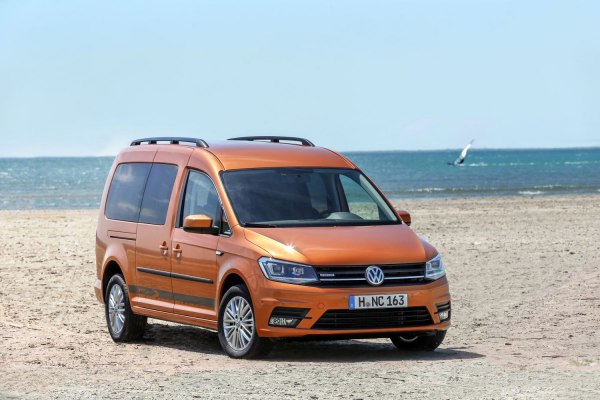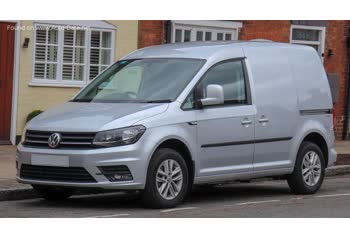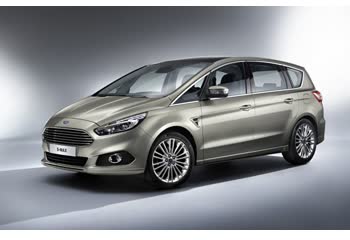Everything you need to know about specifications and performance - Volkswagen Caddy 2015 - 2.0 TDI (150 Hp)

Overview:
What is the engine capacity of a Volkswagen Caddy 2015?
The engine capacity of the Volkswagen Caddy 2015 is 1968 cm.
Volkswagen Caddy 2015 How many horsepower?
The engine power of the Volkswagen Caddy 2015 is 150 Hp @ 3500-4000 rpm..
What is the Volkswagen Caddy 2015 engine?
Volkswagen Caddy 2015 engine is EA288 / CUUB, DFSB. (Click to see other cars using the same engine)
How much gasoline does a Volkswagen Caddy 2015 consume?
The Volkswagen Caddy 2015 consumes 4.9-5.5 liters of gasoline per 100 km
General:
Brand: Volkswagen
Model: Caddy
Generation: Caddy IV
Modification (Engine): 2.0 TDI (150 Hp)
Start of production: 2015
End of production: 2020
Powertrain Architecture: Internal Combustion Engine
Body type:Mini van
Seats: 5-7
Doors: 5
Engine:
Engine systems: Start & Stop System
Power: 150 hp @ 3500-4000 rpm.
Power per litre: 76.2 hp/l
Torque: 340 nm @ 1750-3000 rpm.
Engine Model/Code:EA288 / CUUB, DFSB
Engine displacement: 1968 cm
Number of cylinders: 4
Engine configuration: Inline
Number of valves per cylinder: 4
Fuel injection system: Diesel Commonrail
Engine aspiration: Turbocharger, Intercooler
Valvetrain: DOHC
Engine oil capacity: 4.6 l
Engine layout: Front, Transverse
Cylinder Bore: 81 mm
Piston Stroke: 95.5 mm
Compression ratio: 16.2
Performance:
Fuel Type: Diesel
Fuel consumption (economy) - urban: 6-6.8 l/100 km
Fuel consumption (economy) - extra urban: 4.3-4.7 l/100 km
Fuel consumption (economy) - combined (NEDC): 4.9-5.5 l/100 km
Fuel consumption (economy) - urban (NEDC): 6-6.8 l/100 km
Fuel consumption (economy) - extra urban (NEDC): 4.3-4.7 l/100 km
Fuel consumption (economy) - combined: 4.9-5.5 l/100 km
Emission standard: Euro 6
Acceleration 0 - 100 km/h: 9.9 sec
Acceleration 0 - 62 mph: 9.9 sec
Maximum speed: 194 km/h
Weight-to-power ratio: 9.3 kg/Hp, 107 Hp/tonne
Weight-to-torque ratio: 4.1 kg/Nm, 242.5 Nm/tonne
Acceleration 0 - 60 mph: 9.4 sec
Space:
Kerb Weight: 1402-1422 kg
Max. weight: 2255-2275 kg
Max. roof load: 100 kg
Max load: 853 kg
Trunk (boot) space - maximum: 3030 l
Trunk (boot) space - minimum: 190 l
Permitted trailer load with brakes (12%): 1500 kg
Fuel tank capacity: 55 l
AdBlue tank: 9 l
Permitted trailer load without brakes: 730 kg
Permitted towbar download: 75 kg
dimensions:
Ramp-over (brakeover) angle: 13.5°
Length: 4408 mm
Width: 1793 mm
Height: 1858 mm
wheelbase: 2682 mm
Width including mirrors: 2079 mm
Front overhang: 879 mm
Rear overhang: 847 mm
Ride height (ground clearance): 155 mm
Minimum turning circle (turning diameter): 11.1 m
Approach angle: 15.7°
Departure angle: 17.5°
Powertrain, Suspension and Brakes:
Drivetrain Architecture: The Internal combustion Engine (ICE) drives the front wheels of the vehicle.
Drive wheel: Front wheel drive
Number of gears and type of gearbox: 6 gears, manual transmission
Front brakes: Ventilated discs, 312x25 mm
Rear brakes: Disc, 272x10 mm
Assisting systems: ABS (Anti-lock braking system)
Steering type: Steering rack and pinion
Power steering: Electric Steering
Tires size: 205/55 R16
Wheel rims size: 6J x 16
Front suspension: Independent, type McPherson with coil Spring and anti-roll bar
Rear suspension: Rigid axle suspension, Transverse stabilizer, Leaf Spring
See also

Other generation.
Its production began in 2015 until 2020

Same production year and almost the same engine capacity.
Its production began in 2015 until 2018
Write a comment